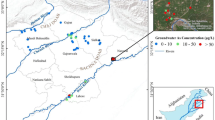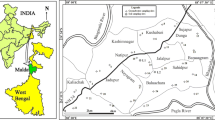Abstract
Shallow tube well (STW) water, often contaminated with arsenic (As), is used extensively in Bangladesh for irrigating rice fields in the dry season, leading to potential As accumulation in soils. In the current study the consequences of arsenic from irrigation water and direct surface (0–15 cm) soil application were studied under field conditions with wetland rice culture over 2 years. Twenty PVC cylinders (30-cm length and 30-cm diameter) were installed in field plots to evaluate the mobility and vertical distribution of soil As, As mass balance, and the resulting influences on rice yield and plant-As concentration in Boro (dry season) and transplanted (T.) Aman (wet season) rice over the 2-year growth cycle. Treatments included irrigation-water As concentrations of 0, 1 and 2 mg L−1 (Boro season only) and soil-As concentrations of 10 and 20 mg kg−1. Following the 2-year cropping sequence the major portion (39.3–47.6%) of the applied arsenic was retained within the rooting zone at 0–15 cm depth, with 14.7–19.5% of the total applied As at the 5–10 cm and 10–15 cm soil depths compared to 1.3–3.6% at the 35–40 cm soil depth. These results indicate the relatively low mobility of applied As and the likely continued detrimental accumulation of As within the rooting zone. Arsenic addition in either irrigation water or as soil-applied As resulted in yield reductions from 21 to 74 % in Boro rice and 8 to 80 % in T. Aman rice, the latter indicating the strong residual effect of As on subsequent crops. The As concentrations in rice grain (0.22 to 0.81 µg g−1), straw (2.64 to 12.52 µg g−1) and husk (1.20 to 2.48 µg g−1) increased with increasing addition of As. These results indicate the detrimental impacts of continued long-term irrigation with As-contaminated water on agricultural sustainability, food security and food quality in Bangladesh. A critical need exists for the development of crop and water management strategies to minimize potential As hazard in wetland rice production.


Similar content being viewed by others
References
Abedin MJ, Feldmann J, Meharg AA (2002) Uptake kinetics of arsenic species in rice plants. Plant Physiol 128:1120–1128
Agusa T, Kunito T, Minh TB, Kim Trang PT, Iwata H, Viet PH, Tanabe S (2009) Relationship of urinary arsenic metabolites to intake estimates in residents of the Red River Delta, Vietnam. Environ Pollut 157:396–403
Bremner JM, Mulvancy CS (1982) In: Page AL et al (eds) Methods of Soil Analysis, Part 2. Wis, Amer Soc Agron Inc, Madi
Dittmar J, Voegelin A, Roberts LC, Hug SJ, Saha GC, Ali MA, Badruzzaman ABM, Kretzschmar R (2007) Spatial distribution and temperal variability of arsenic in irrigated rice fields in Bangladesh. 2. Paddy soil. Environ Sci Technol 41:5967–5972
Duxbury JM, Mayer AB, Lauren JG, Hassan N (2003) Food chain aspects of arsenic contamination in Bangladesh: Effects on quality and productivity of rice. J Environ Sci Health 38:61–69
Gomez KA, Gomez AA (1984) Statistical Procedures for Agricultural Research. Wiley, NY
Heikens A, Panaullah GM, Meharg AA (2007) Arsenic behaviour from groundwater and soil to crops: impacts on agriculture and food safety. Rev Environ Contam Toxicol 189:43–87
Hossian MB, Jahiruddin M, Panaullah GM, Loeppert RH, Islam MR, Duxbury JM (2008) Spatial variability of arsenic concentration in soils and plants, and its relationship with iron, manganese and phosphorus. Environ Pollut 56:739–744
Huq SMI, Joardar JC, Parvin S, Correll R, Naidu R (2006) Arsenic contamination in food-chain: Transfer of arsenic into food materials through groundwater irrigation. J Health Pop Nutr 24:305–316
Islam MR, Jahiruddin M, Rahman GKM, Mia MAM, Farid ATM, Panaullah GM, Loeppert RH, Duxbury JM, Meisner CA (2005) Arsenic in paddy soils of Bangladesh: levels, distribution and contribution of irrigation and sediments. Proc. Behaviours of arsenic in aquifers, soils and plants: Implications for management symposium, Dhaka, Bangladesh.
Islam MR, Jahiruddin M, Islam S (2007) Arsenic linkage in the irrigation water-soil-rice plant systems. Pak J Sci Indust Res 50:85–90
Islam S, Islam MR, Jahiruddin M, Imtiaz MF (2009) Effect of arsenic contamination on arsenic and nutrient concentrations of Boro rice genotypes. J Environ Sci & Nat Resour 2:103–110
Jahiruddin M, Islam MA, Islam MR, Islam S (2004) Effects of As contamination on rice crop ( Oryza sativa L). Environtropica 1:104–110
Khan MA, Islam MR, Panaullah GM, Duxbury JM, Jahiruddin M, Loeppert RH (2009) Fate of irrigation-water arsenic in rice soils of Bangladesh. Plant Soil. doi:10.1007/s11104-009-9914-3
Kile ML, Houseman EA, Breton CV, Smith T, Quamruzzaman Q, Rahman M, Mahiuddin G, Christiani DC (2007) Dietary arsenic exposure in Bangladesh. Environ Health Perspectives 115:889–893
Li RY, Stroud JL, Ma JF, McGrath SP, Zhao FJ (2009) Mitigation of arsenic accumulation in rice with water management and silicon fertilization. Environ Sci Technol 43:1612–1617
Meharg AA, Rahman MM (2003) Arsenic contamination of Bangladesh paddy field soils; implications for rice contribution to arsenic consumption. Environ Sci Technol 15 37(2):229–234
Mondal D, Polya DA (2008) Rice is a major exposure route for arsenic in Chakdaha block, Nadia district, West Bengal, India:A probabilistic risk assessment. Appl Geochem 23:2986–2997
Moslehuddin AZM, Islam MR, Ahmed IU, Egashira K (2003) Mineralogy of soils from different agroecological regions of Bangladesh: Region 9-Old Brahmaputra Floodplain. Clay Science 12:147–152
Norra S, Berner ZA, Agarwala P, Wagner F, Chandrasekharam D, Stuben D (2005) Impact of irrigation with As rich groundwater on soil and crops: A geochemical case study in West Bengal Delta Plain, India. Applied Geochem 20(10):1980–1906
Ohno K, Yanase T, Matsuo Y, Kimura T, Rahman MH, Magara Y, Matsui Y (2007) Arsenic intake via water and food by a population living in an arsenic-affected area of Bangladesh. Sci Total Environ 381:68–76
Olsen SR, Sommers LE (1982) In: Page AL et al (eds) Methods of Soil Analysis, Part 2. Wis, Amer Soc Agron Inc, Madi
Panaullah GM, Alam T, Hossain MB, Loeppert RH, Lauren JG, Meisner CA, Ahmed ZU, Duxbury JM (2009) Arsenic toxicity to rice (Oryza sativa L.) in Bangladesh. Plant Soil 317(1):31–39
Peryea FJ, Cregor TL (1994) Vertical distribution of lead and arsenic in soils contaminated with lead arsenate pesticide residues. Water Air Soil Pollut 78:297–306
Saha GC, Ali MA (2007) Dynamics of As in agricultural soils irrigated with As contaminated groundwater in Bangladesh. Sci Tot Environ 379:180–189
Smedley PL, Kinniburgh DG (2002) A review of the source behavior and distribution of arsenic in natural waters. Appl Geochem 17:517–568
Roberts LC, Hug SJ, Dittmar J, Voegelin A, Saha GC, Ali MA, BM BA, Kretzschmar R (2007) Spatial distribution and temporal variability of arsenic in irrigated rice fields in Bangladesh. I. Irrigation Water. Environ Sci Technol 41:5960–5966
Roberts LC, Hug SJ, Dittmar J, Voegelin A, Kretzschmar R, Wehrli B, Cirpka OA, Saha GC, Ali MA, Badruzzaman ABM (2009) Arsenic release from paddy soils during monsoon flooding. Nature Geosci. doi:10.1038/NGEO723
Samanta G, Chowdhury TR, Mandal BK, Biswas BK, Chowdhury UK, Basu GK, Chanda CR, Lodh D, Chakraborti D (1999) Flow injection hydride generation atomic absorption spectrometry for determination of As in water and biological samples from As affected districts of West Bengal, India and Bangladesh. Microchem J 62:174–191
Walkley A, Black DR (1975) An examination of the digestion method for determining soil organic matter and proposed modification of the chronic acid titration method. Soil Sci 37:29–38
Williams PN, Islam MR, Adomako EE, Raab A, Hossain SA, Zhu YG, Feldmann J, Meharg AA (2006) Increase in rice grain As for regions of Bangladesh irrigating paddies with elevated arsenic in ground waters. Environ Sci Technol 40:4903–4908
Williams PN, Villada A, Deacon C, Raab A, Figuerola J, Green AJ, Feldmann J, Meharg AA (2007) Greatly enhanced arsenic shoot assimilation in rice leads to elevated grain levels compared to wheat and barley. Environ Sci Technol 41:6854–6859
Williams PN, Islam S, Islam R, Jahiruddin M, Adomako E, Soliaman ARM, Rahman GKMM LuY, Deacon C, Zhu YG, Meharg AA (2009) Arsenic Limits Trace Mineral Nutrition (Selenium, Zinc, and Nickel) in Bangladesh Rice Grain. Environ Sci Technol 43:8430–8436
Xu XY, McGrath SP, Meharg AA, Zhao FJ (2008) Growing rice aerobically markedly decreases arsenic accumulation. Environ Sci Technol 42:5574–5579
Acknowledgement
The authors gratefully acknowledge support of the US-AID Bangladesh mission through the Cornell-Texas A & M—CIMMYT arsenic project.
Author information
Authors and Affiliations
Corresponding author
Additional information
Responsible Editor: Fangjie Zhao.
Electronic supplementary material
Below is the link to the electronic supplementary material.
SI Figure 1
Lay-out of the field experiment (DOC 609 kb)
SI Table 1
Effects of irrigation water and soil added As on plant height and filled grains panicle−1 during 2004 and 2005 (DOC 16 kb)
Rights and permissions
About this article
Cite this article
Khan, M.A., Islam, M.R., Panaullah, G.M. et al. Accumulation of arsenic in soil and rice under wetland condition in Bangladesh. Plant Soil 333, 263–274 (2010). https://doi.org/10.1007/s11104-010-0340-3
Received:
Accepted:
Published:
Issue Date:
DOI: https://doi.org/10.1007/s11104-010-0340-3




